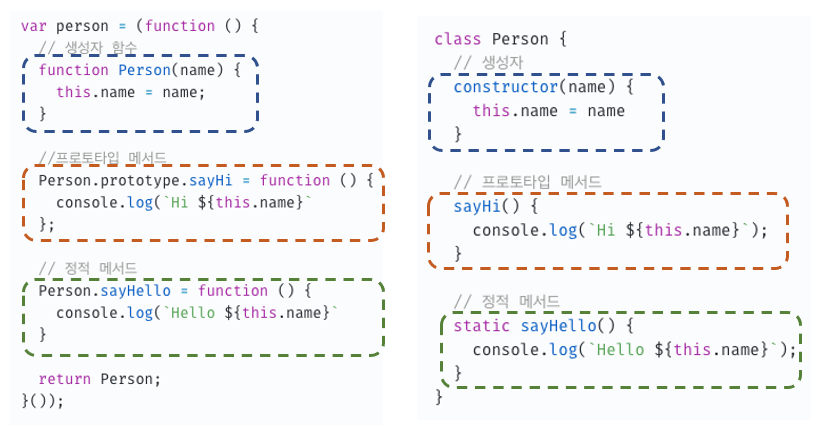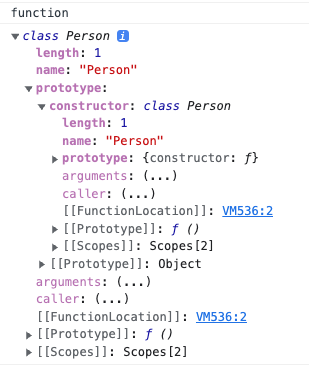
목표
- 25장의 내용을 최대한 이해하고 정리하기
25. 클래스(Class)
25-1. 자바스크립트와 클래스
- 자바스크립트는 프로토타입 기반 객체지향 언어 로 다른 객체지향 언어와 다르지만 객체지향 프로그래밍 능력을 가지고 있다.
- 프로토타입 기반 객체지향 언어는 클래스가 필요 없는 언어이다. ES5에서는 클래스 없이도 생성자 함수와 프로토타입을 통해 객체지향 언어의 상속을 구현할 수 있었다.
// 생성자 함수
var Person = (function () {
function Persion(name) {
this.name = name;
}
// 프로토타입 메서드
Person.prototype.sayHi = functon () {
console.log("Hi! My name is "+ this.name);
};
return Person;
}());
var me = new Person("Lee");
me.sayHi();- 하지만, ES6에서 도입된 클래스 는 자바나 C와 같은 클래스 객체지향 프로그래밍 언어와 비슷한 새로운 객체 생성 매커니즘을 제시했다.
- 그렇다고 ES6 클래스가 기존의 프로토타입 기반 객체지향 모델을 폐지하는 것이 아니고 기존 프로토타입 기반 패턴을 클래스 기반 패턴처럼 사용하도록 만든 것이다.
25-1-1. 클래스와 생성자 함수
- 클래스와 생성자 함수는 모두 프로토타입 기반의 인스턴스를 생성하지만 정확히 동일하게 동작하지는 않는다.
- 클래스는 생성자 함수보다 엄격하며 다음과 같은 몇 가지 차이가 있다.
- 생성자 함수는 new 연산자 없이 호출하면 일반 함수로 호출되지만 클래스를 new 없이 호출하면 에러가 발생한다.
- 클래스는 생성자 함수와 달리 extends와 super 키워드를 지원한다.
- 클래스는 생성자 함수와 달리 클래스 내의 모든 코드는 암묵적으로 strict mode가 지정되어 실행되며 해제할 수 없다.
25-2. 클래스 정의
- 클래스는 class 키워드로 정의한다.
- 클래스 이름은 파스칼 케이스(앞의 글자가 대문자)를 사용하는 것이 일반적이다. 물론, 파스칼 케이스를 사용하지 않아도 에러는 발생하지 않는다.
class Person {}- 클래스 내부에 constructor(생성자), 프로토타입 메서드, 정적 메서드 등과 같은 메서드들을 추가할 수 있다.
class Person {
// 생성자
constructor(name) {
this.name = name
}
// 프로토타입 메서드
sayHi() {
// 인스턴스로 호출
console.log(`Hi ${this.name}`);
}
// 정적 메서드
static sayHello() {
// 클래스로 호출
console.log(`Hello ${this.name}`);
}
}
const me = new Person("Lee");
console.log(me.name);
me.sayHi();
Person.sayHello();
// 결과
"Lee"
"Hi Lee"
"Hello Person"25-2-1. 생성자 함수와 클래스 정의 비교
- 왼쪽은 생성자 함수고, 오른쪽은 클래스이다.

25-3. 클래스 호이스팅 생략
25-4. 인스턴스 생성
- 클래스는 생성자 함수의 일종이며 new 연산자와 함께 호출되어 인스턴스를 생성한다.
class Person {}
const me = new Person();
console.log(me);- 클래스는 반드시 new 연산자와 함께 호출해야 한다. 그렇지 않으면 다음과 같은 에러가 발생한다.
class Person {}
const me = Person();
// 결과
"Uncaught TypeError: Class constructor Person cannot be invoked without 'new'"25-5. 메서드
- 클래스 몸체에서 정의할 수 있는 메서드는 constructor(생성자), 프로토타입 메서드, 정적 메서드 세 가지가 있다.
25-5-1. constructor
- 생성자(constructor) 는 인스턴스를 생성하고 초기화하기 위한 특수한 메서드이다.
class Person {
constructor(name) {
// 인스턴스 생성 및 초기화
this.name = name;
}
}- 위 코드를 브라우저 개발자도구 콘솔에서 찍어보면 다음과 같다.
console.log(typeof Person); // function
console.dir(Person);
- 클래스는 평가되어 함수 객체가 되고 함수 객체는 고유의 프로퍼티를 가지고 있다.
- constructor의 특징은 다음과 같다.
- constructor는 클래스 내의 최대 한 개만 존재할 수 있다. 2개 이상일 경우 문법 에러가 발생한다.
class Person {
constructor() {}
constructor() {}
}
// 결과
"Uncaught SyntaxError: A class may only have one constructor"- constructor는 생략할 수 있다. 생략하면 빈 constructor가 암묵적으로 정의된다.
class Person {}- 인스턴스를 생성할 때 클래스 외부에서 인스턴스 프로퍼티의 초기값을 전달하려면 constructor에 매개변수를 선언하고 인스턴스를 생성할 때 초기값을 전달하면 된다.
class Person {
constructor(name, address) {
this.name = name;
this.address = address;
}
}
const me = new Person("Lee", "Seoul");
console.log(me);- constructor는 별도의 반환문을 갖지 않아야 한다. new 연산자와 함께 클래스가 호출되면 암묵적으로 this(인스턴스)를 반환하기 때문이다.
class Person {
constructor(name) {
this.name = name;
return {};
}
}
const me = new Person("Lee");
console.log(me);- 위 코드에서 constructor 내부에서 명시적으로 다른 값을 반환하는 것은 클래스의 기본 동작을 훼손하는 행위이므로 return문을 반드시 생략해야 한다.
25-5-2. 프로토타입 메서드
- 클래스 몸체에서 정의한 메서드는 생성자 함수와 달리 prototype 프로퍼티에 메서드를 추가하지 않아도 기본적으로 프로토타입 메서드가 된다.
class Person {
constructor(name) {
this.name = name;
}
sayHi() {
console.log(`my name is ${this.name}`);
}
}
const me = new Person("Lee");
me.sayHi();
// 결과
"my name is Lee"25-5-3. 정적 메서드
- 정적 메서드는 인스턴스를 생성하지 않아도 호출할 수 있는 메서드이다.
class Person {
constructor(name) {
this.name = name;
}
static sayHi() {
console.log(`my name is ${this.name}`);
}
}
Person.sayHi();
// 결과
"my name is Person"25-5-4. 클래스에서 정의한 메서드의 특징
- function 키워드를 생략한 메서드 축약 표현을 사용한다.
- 객체 리터럴과는 다르게 클래스에 메서드를 정의할 때는 콤마가 필요 없다.
- 암묵적으로 strict mode로 실행된다.
- for ... in 문이나 Object.keys 메서드 등으로 열거할 수 없다.
- 내부 메서드 [[Construct]] 를 갖지 않는 non-constructor이다. 따라서, new 연산자와 함께 호출할 수 없다.
25-6. 클래스의 인스턴스 생성 과정
1. 인스턴스 생성과 this 바인딩
- new 연산자 함께 클래스를 호출하면 암묵적으로 빈 객체가 생성된다. 이 객체는 클래스가 생성한 인스턴스가 될 객체이다.
- 클래스가 생성한 인스턴스의 프로토타입으로 클래스의 prototype 프로퍼티가 가리키는 객체가 설정된다.
- 생성된 객체 즉, 인스턴스는 this에 바인딩된다. 따라서, constructor 내부의 this는 인스턴스를 가리킨다.
2. 인스턴스 초기화
- constructor의 내부 코드가 실행되어 this에 바인딩되어 있는 인스턴스를 초기화한다.
- this에 바인딩되어 있는 인스턴스에 프로퍼티를 추가하고 constructor가 인수로 전달받은 값으로 인스턴스의 프로퍼티 값을 초기화한다.
3. 인스턴스 반환
- 클래스의 모든 처리가 끝나면 완성된 인스턴스가 바인딩된 this를 암묵적으로 반환한다.
class Person {
constructor(name) {
// 1. 암묵적으로 인스턴스가 생성되고 this에 바인딩된다.
console.log(this);
console.log(Object.getPrototypeOf(this) === Person.prototype);
// 2. this에 바인딩되어 있는 인스턴스를 초기화한다.
this.name = name;
console.log(this);
// 3. this가 암묵적으로 반환된다.
}
}
const me = new Person("james");
// 결과
Person {}
true
Person {name: 'james'}25-7. 프로퍼티
25-7-1. 인스턴스 프로퍼티
- 인스턴스 프로퍼티는 constructor 내부에서 정의해야 한다.
class Person {
constructor(name) {
// 인스턴스 프로퍼티
this.name = name;
}
}
const me = new Person("Lee");
console.log(me);25-7-2. 접근자 프로퍼티
- 접근자 프로퍼티는 자체적으로 값을 갖지 않고 다른 데이터 프로퍼티의 값을 읽거나 저장할 때 사용하는 접근자 함수로 구성된 프로퍼티이다.
class Person {
constructor(firstName, lastName) {
this.firstName = firstName;
this.lastName = lastName;
}
get fullName() {
return `${this.firstName} ${this.lastName}`;
}
set fullName(name) {
[this.firstName, this.lastName] = name.split(' ');
}
}
const me = new Person('heedo', 'na');
console.log(`${me.firstName} ${me.lastName}`);
me.fullName = "yijon back";
console.log(me.fullName);
// 결과
"heedo na"
"yijon back"- 접근자 프로퍼티는 getter 함수와 setter 함수로 구성되어 있다.
- getter는 인스턴스 프로퍼티에 접근할 때마다 프로퍼티 값을 조작하거나 별도의 행위가 필요할 때 사용한다.
- setter는 인스턴스 프로퍼티에 값을 할당할 때마다 프로퍼티 값을 조작하거나 별도의 행위가 필요할 때 사용한다.
25-7-3. 클래스 필드 정의 제안
- 클래스 필드(class field)는 클래스 기반 객체지향 언어에서 클래스가 생성할 인스턴스의 프로퍼티를 말하며 클래스 멤버라고도 부른다.
- 자바스크립트의 클래스에서 인스턴스 프로퍼티를 선언하고 초기화하려면 반드시 constructor 내부에서 this에 프로퍼티를 추가해야 한다.
class Person {
name = "Lee";
}
const me = new Person("Lee");- 그렇다면 this에 프로퍼티를 추가하지 않은 위의 코드는 에러가 발생할까?
- 발생할 수도 있고 아닐 수도 있는데 최신 브라우저 또는 최신 Node.js(12 버전 이상)에서 실행하면 정상적으로 잘 동작한다.
- 클래스 몸체에서 클래스 필드를 정의할 수 있는 클래스 필드 정의 제안은 ECMAScript의 정식 표준 사양으로 승급되지 않았지만 최신 브라우저 및 Node.js는 표준 사용으로 승급이 확실시되는 이 제안을 선제적으로 미리 구현해 놓았다.
- 그렇다면 클래스 필드는 언제 사용할까?
class Person {
// 클래스 필드 정의
name;
constructor(name) {
this.name = name;
}
getName = function () {
return this.name;
}
}
const me = new Person("Lee");
console.log(me);
console.log(me.getName());
// 결과
Person {name: "Lee"}
"Lee"- 위 코드와 같이 인스턴스를 생성할 때 외부의 초기값으로 클래스 필드를 초기화해야 한다면 굳이 constructor 밖에서 클래스 필드를 정의할 필요가 없다.
- 어차피 클래스가 생성한 인스턴스에 클래스 필드에 해당하는 프로퍼티가 없다면 자동으로 추가되기 때문이다.
인스턴스 프로퍼티를 정의하는 방식
- 인스턴스를 생성할 때
- 외부 초기값으로 클래스 필드를 초기화할 필요가 있다면 constructor에서 인스턴스 프로퍼티를 정의하는 기존 방식을 사용한다.
- 외부 초기값으로 클래스 필드를 초기화할 필요가 없다면 기존 constructor에서 인스턴스 프로퍼티를 정의하는 방식과 클래스 필드 정의 제안 모두 사용할 수 있다.
25-7-4. private 필드 정의 제안
- 자바스크립트는 다른 객체지향 언어와 달리 private, protected 키워드와 같은 접근 제한자를 제공하지 않는 등 캡슐화를 완벽하게 지원하지 않는다.
- 인스턴스 프로퍼티는 인스턴스를 통해 클래스 외부에서 언제나 참조할 수 있으므로 public하며 외부에 그대로 노출될 수 있다.
- 다행히도 최신 브라우저와 Node.js에 private 필드를 정의할 수 있는 새로운 표준 사양이 제안되어 있다.
class Person {
#name = "";
constructor(name) {
this.#name = name;
}
}
const me = new Person("Lee");
console.log(me.#name);
// 결과
"Uncaught SyntaxError: Private field '#name' must be declared in an enclosing class"- private 필드의 선두에는 #을 붙여준다. 또한, 참조할 때에도 #을 붙어주어야 한다.
- private 필드는클래스 내부에서만 참조할 수 있다. 다만, 접근자 프로퍼티를 통해 간접적으로 접근하는 방법이 있다.
class Person {
#name = '';
constructor(name) {
this.#name = name;
}
get getName() {
return this.#name.trim();
}
}
const me = new Person("Lee");
console.log(me.getName);
// 결과
"Lee"25-7-5. static 필드 정의 제안
- 클래스에는 static 키워드를 사용하여 정적 메서드를 정의할 수 있지만 static 키워드를 사용하여 정적 필드를 정의할 수는 없다.
- 하지만, 최신 브라우저 및 Node.js에는 static public 필드, static private 필드, static private 메서드를 정의할 수 있게 되었다.
class MyMath {
// static public 필드 정의
static PI = 21 / 7;
// static private 필드 정의
static #num = 10;
// static 메서드
static increment() {
return ++Mymath.#num;
}
console.log(MyMath.PI);
console.log(MyMath.increment());
}